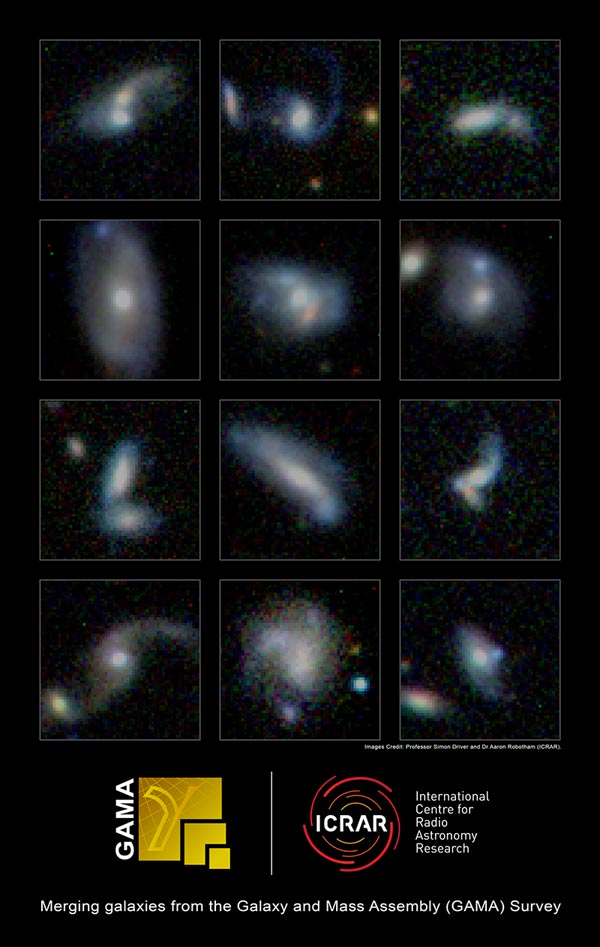Monster galaxies gain weight by eating smaller neighbours

Astronomers looked at more than 22,000 galaxies and found that while smaller galaxies were very efficient at creating stars from gas, the most massive galaxies were much less efficient at star formation, producing hardly any new stars themselves, and instead grew by eating other galaxies.
The study was released today in the journal Monthly Notices of the Royal Astronomical Society, published by Oxford University Press.
Dr Aaron Robotham based at The University of Western Australia node of the International Centre for Radio Astronomy Research (ICRAR), said smaller ‘dwarf’ galaxies were being eaten by their larger counterparts.
“All galaxies start off small and grow by collecting gas and quite efficiently turning it into stars,” he said.
“Then every now and then they get completely cannibalised by some much larger galaxy.”
Dr Robotham, who led the research, said our own Milky Way was at a tipping point and expected to now grow mainly by eating smaller galaxies, rather than by collecting gas.
“The Milky Way hasn’t merged with another large galaxy for a long time but you can still see remnants of all the old galaxies we’ve cannibalised,” he said.
“We’re also going to eat two nearby dwarf galaxies, the Large and Small Magellanic Clouds, in about four billion years.”But Dr Robotham said the Milky Way would eventually get its comeuppance when it merged with the nearby Andromeda Galaxy in about five billion years.
“Technically, Andromeda will eat us because it’s the more massive one,” he said.
Almost all of the data for the research was collected with the Anglo-Australian Telescope in New South Wales as part of the Galaxy And Mass Assembly (GAMA) survey, led by Professor Simon Driver at ICRAR.
The GAMA survey involves more than 90 scientists and took seven years to complete.
This study is one of more than 60 publications to have come from the work, with another 180 in progress.
Dr Robotham said as galaxies grew they had more gravity and could therefore more easily pull in their neighbours.
He said the reason star formation slowed down in really massive galaxies was thought to be because of extreme feedback events in a very bright region at the centre of a galaxy known as an active galactic nucleus.
“The topic is much debated, but a popular mechanism is where the active galactic nucleus basically cooks the gas and prevents it from cooling down to form stars,” Dr Robotham said.
Ultimately, gravity is expected to cause all the galaxies in bound groups and clusters to merge into a few super-giant galaxies, although we will have to wait many billions of years before that happens.
“If you waited a really, really, really long time that would eventually happen but by really long I mean many times the age of the Universe so far,” Dr Robotham said.
ICRAR is a joint venture between Curtin University and The University of Western Australia with support and funding from the State Government of Western Australia.
‘Galaxy and Mass Assembly (GAMA): Galaxy close-pairs, mergers and the future fate of stellar mass’ in the Monthly Notices of the Royal Astronomical Society. Published online 19/9/2014 at: http://mnras.oxfordjournals.org/lookup/doi/10.1093/mnras/stu1604
Preprint version accessible at: http://arxiv.org/abs/1408.1476
Dr Aaron Robotham
ICRAR – UWA (Currently travelling in South Africa, GMT +2:00)
E: aaron.robotham@icrar.org
Professor Simon Driver
Principal Investigator of the GAMA project. ICRAR – UWA (Perth, GMT +8:00)
Ph: +61 8 6488 7747 M: +61 400 713 514 E: simon.driver@icrar.org
Kirsten Gottschalk
Media Contact, ICRAR (Perth, GMT +8:00)
Ph: +61 8 6488 7771 M: +61 438 361 876 E: kirsten.gottschalk@icrar.org
UWA Media Office
Ph: +61 8 6488 7977
Media Contact
All latest news from the category: Physics and Astronomy
This area deals with the fundamental laws and building blocks of nature and how they interact, the properties and the behavior of matter, and research into space and time and their structures.
innovations-report provides in-depth reports and articles on subjects such as astrophysics, laser technologies, nuclear, quantum, particle and solid-state physics, nanotechnologies, planetary research and findings (Mars, Venus) and developments related to the Hubble Telescope.
Newest articles

A universal framework for spatial biology
SpatialData is a freely accessible tool to unify and integrate data from different omics technologies accounting for spatial information, which can provide holistic insights into health and disease. Biological processes…

How complex biological processes arise
A $20 million grant from the U.S. National Science Foundation (NSF) will support the establishment and operation of the National Synthesis Center for Emergence in the Molecular and Cellular Sciences (NCEMS) at…

Airborne single-photon lidar system achieves high-resolution 3D imaging
Compact, low-power system opens doors for photon-efficient drone and satellite-based environmental monitoring and mapping. Researchers have developed a compact and lightweight single-photon airborne lidar system that can acquire high-resolution 3D…





















